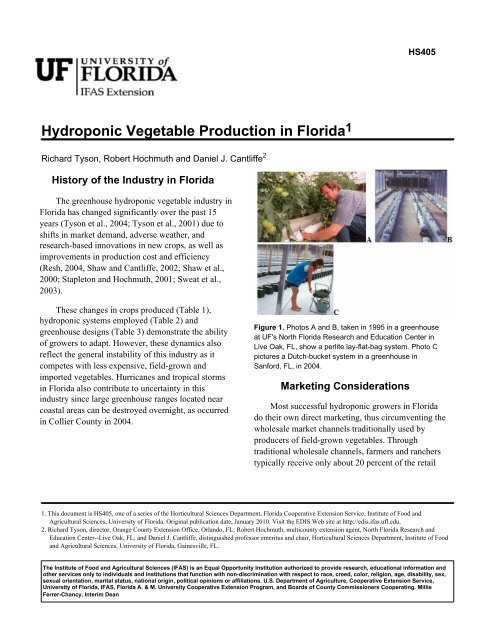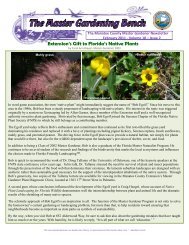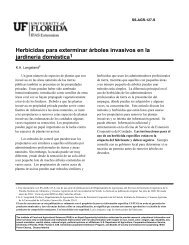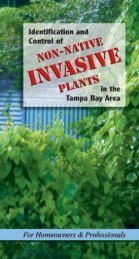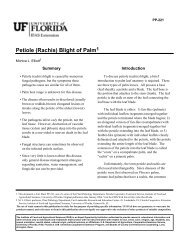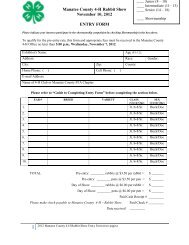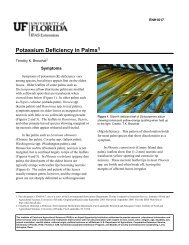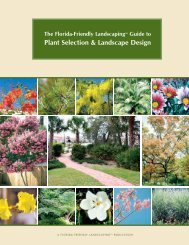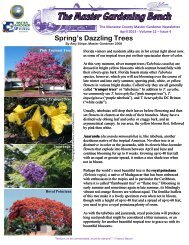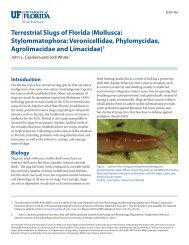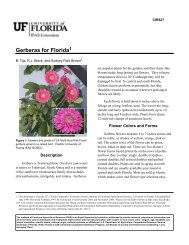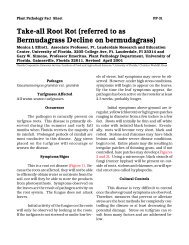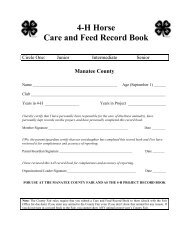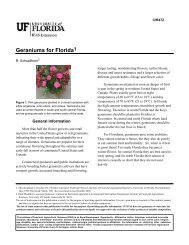Hydroponic Vegetable Production in Florida - Manatee County ...
Hydroponic Vegetable Production in Florida - Manatee County ...
Hydroponic Vegetable Production in Florida - Manatee County ...
You also want an ePaper? Increase the reach of your titles
YUMPU automatically turns print PDFs into web optimized ePapers that Google loves.
HS405<strong>Hydroponic</strong> <strong>Vegetable</strong> <strong>Production</strong> <strong>in</strong> <strong>Florida</strong> 1Richard Tyson, Robert Hochmuth and Daniel J. Cantliffe 2History of the Industry <strong>in</strong> <strong>Florida</strong>The greenhouse hydroponic vegetable <strong>in</strong>dustry <strong>in</strong><strong>Florida</strong> has changed significantly over the past 15years (Tyson et al., 2004; Tyson et al., 2001) due toshifts <strong>in</strong> market demand, adverse weather, andresearch-based <strong>in</strong>novations <strong>in</strong> new crops, as well asimprovements <strong>in</strong> production cost and efficiency(Resh, 2004, Shaw and Cantliffe, 2002; Shaw et al.,2000; Stapleton and Hochmuth, 2001; Sweat et al.,2003).These changes <strong>in</strong> crops produced (Table 1),hydroponic systems employed (Table 2) andgreenhouse designs (Table 3) demonstrate the abilityof growers to adapt. However, these dynamics alsoreflect the general <strong>in</strong>stability of this <strong>in</strong>dustry as itcompetes with less expensive, field-grown andimported vegetables. Hurricanes and tropical storms<strong>in</strong> <strong>Florida</strong> also contribute to uncerta<strong>in</strong>ty <strong>in</strong> this<strong>in</strong>dustry s<strong>in</strong>ce large greenhouse ranges located nearcoastal areas can be destroyed overnight, as occurred<strong>in</strong> Collier <strong>County</strong> <strong>in</strong> 2004.Figure 1. Photos A and B, taken <strong>in</strong> 1995 <strong>in</strong> a greenhouseat UF's North <strong>Florida</strong> Research and Education Center <strong>in</strong>Live Oak, FL, show a perlite lay-flat-bag system. Photo Cpictures a Dutch-bucket system <strong>in</strong> a greenhouse <strong>in</strong>Sanford, FL, <strong>in</strong> 2004.Market<strong>in</strong>g ConsiderationsMost successful hydroponic growers <strong>in</strong> <strong>Florida</strong>do their own direct market<strong>in</strong>g, thus circumvent<strong>in</strong>g thewholesale market channels traditionally used byproducers of field-grown vegetables. Throughtraditional wholesale channels, farmers and rancherstypically receive only about 20 percent of the retail1. This document is HS405, one of a series of the Horticultural Sciences Department, <strong>Florida</strong> Cooperative Extension Service, Institute of Food andAgricultural Sciences, University of <strong>Florida</strong>. Orig<strong>in</strong>al publication date, January 2010. Visit the EDIS Web site at http://edis.ifas.ufl.edu.2. Richard Tyson, director, Orange <strong>County</strong> Extension Office, Orlando, FL; Robert Hochmuth, multicounty extension agent, North <strong>Florida</strong> Research andEducation Center--Live Oak, FL; and Daniel J. Cantliffe, dist<strong>in</strong>guished professor emeritus and chair, Horticultural Sciences Department, Institute of Foodand Agricultural Sciences, University of <strong>Florida</strong>, Ga<strong>in</strong>esville, FL.The Institute of Food and Agricultural Sciences (IFAS) is an Equal Opportunity Institution authorized to provide research, educational <strong>in</strong>formation andother services only to <strong>in</strong>dividuals and <strong>in</strong>stitutions that function with non-discrim<strong>in</strong>ation with respect to race, creed, color, religion, age, disability, sex,sexual orientation, marital status, national orig<strong>in</strong>, political op<strong>in</strong>ions or affiliations. U.S. Department of Agriculture, Cooperative Extension Service,University of <strong>Florida</strong>, IFAS, <strong>Florida</strong> A. & M. University Cooperative Extension Program, and Boards of <strong>County</strong> Commissioners Cooperat<strong>in</strong>g. MillieFerrer-Chancy, Interim Dean
<strong>Hydroponic</strong> <strong>Vegetable</strong> <strong>Production</strong> <strong>in</strong> <strong>Florida</strong> 2value of their crop (Anonymous, 2009). Off-farmcosts -- <strong>in</strong>clud<strong>in</strong>g market<strong>in</strong>g, process<strong>in</strong>g,wholesal<strong>in</strong>g, distribution and retail<strong>in</strong>g -- account for80 cents of every retail food dollar spent <strong>in</strong> the UnitedStates. However, producers' chances for successimprove when they place their crops as close aspossible to retail markets -- restaurants, cafeterias,hotels, cruise ships, farmers markets, on-farm-sales,etc.Because of the greater cost per pound ofproduc<strong>in</strong>g hydroponic vegetables -- as compared totraditional, field-grown vegetables -- hydroponicgrowers, to be successful, need to receive 50 - 100percent of the retail value for their crops. Actual retailvalues can be determ<strong>in</strong>ed easily by check<strong>in</strong>g severallocal retail grocery stores for vegetable prices.However, to move large loads, high-volumeproducers (>0.5 acre) will still need to cultivate somewholesale markets (with lower prices per poundshipped).<strong>Hydroponic</strong> Grow<strong>in</strong>g SystemsBased on the latest published data (Table 1),hydroponic-crop rank<strong>in</strong>gs <strong>in</strong> <strong>Florida</strong> – ordered frommost grown to least grown – were the follow<strong>in</strong>g:herbs, peppers, cucumbers, tomatoes, lettuce, mixedvegetable/herb, and strawberries.Perlite systems for grow<strong>in</strong>g vegetableshydroponically are varied <strong>in</strong> design. One system usesdrip-irrigated, perlite-filled, lay-flat plastic bags. (SeeFigure 1). These cigar-shaped bags are placed <strong>in</strong> tworows, runn<strong>in</strong>g the length of the greenhouse withaccess aisles <strong>in</strong> between. Slits are made at the bottomor slightly up one side of each bag for dra<strong>in</strong>age to acentral collection trough runn<strong>in</strong>g between the rows.Effluent from the bags collects <strong>in</strong> the trough and mayrema<strong>in</strong> there or run by gravity to a collection tank.Another common perlite system uses Dutchbuckets. This system consists of plastic, two-gallonbuckets conta<strong>in</strong><strong>in</strong>g perlite and with a 2-two <strong>in</strong>chreservoir at the bottom. Drip irrigation supplies waterand nutrients, which overflow the reservoir and arecollected to dra<strong>in</strong> or recycled through a PVC pipe.Perlite is also used <strong>in</strong> a variety of other cropp<strong>in</strong>gsystems, <strong>in</strong>clud<strong>in</strong>g the bench-bed system (example:perlite-filled, alum<strong>in</strong>um roof<strong>in</strong>g panels) and verticalsystems (described below). When used <strong>in</strong> thesesystems, perlite is often mixed with coconut coir,peat, or other organic components to <strong>in</strong>crease waterand nutrient hold<strong>in</strong>g capacity of the media.These crops were produced <strong>in</strong> the follow<strong>in</strong>gproduction/media type systems (Table 2): perlite(Dutch bucket, lay flat bag); various media-fillednursery pots or upright bags; raised beds or sandfloor; nutrient film (flow) technique (NFT); float<strong>in</strong>graft systems; vertical systems; or rockwool.Greenhouse design (Table 3) was natural ventilationor pad and fan with mostly double polyethylenecovers <strong>in</strong> multiple-bay greenhouses.PerlitePerlite is a generic term for naturally occurr<strong>in</strong>gvolcanic glass or rock, which is heated and, <strong>in</strong>response, expands from four to 20 times its orig<strong>in</strong>alvolume. The result is a white, angular, pearl-likepebble that is light weight and adaptable for numerousapplications, <strong>in</strong>clud<strong>in</strong>g as horticultural media.Figure 2. Tomatoes grow<strong>in</strong>g <strong>in</strong> media-filled, plastic nurserypots (A) and <strong>in</strong> upright bags (B) <strong>in</strong> a greenhouse <strong>in</strong>Wellborn, FL, <strong>in</strong> 2001.
<strong>Hydroponic</strong> <strong>Vegetable</strong> <strong>Production</strong> <strong>in</strong> <strong>Florida</strong> 3Media Filled Plastic Nursery Pots or UprightBagsMedia filled plastic nursery pots (Figure 2A) orupright bags (Figure 2B) can be spaced <strong>in</strong> two rowssimilar to lay-flat bag and rockwool culture. Thissystem is similar to those used by ornamental growers<strong>in</strong> <strong>Florida</strong>, who grow drip-irrigated foliage orlandscape plants <strong>in</strong> conta<strong>in</strong>ers.Composted p<strong>in</strong>e bark is a common media withthis system because of the availability of this mediafrom the forest-pulp <strong>in</strong>dustry <strong>in</strong> <strong>Florida</strong>. Other mediacommonly used <strong>in</strong> this system <strong>in</strong>clude one or morecomb<strong>in</strong>ations of peat, perlite and vermiculite.Drip irrigation supplies a nutrient solution to theconta<strong>in</strong>ers. The solution is usually not re-circulated,but timed to pulse-flow through the conta<strong>in</strong>ers.Figure 3. Bibb lettuce grow<strong>in</strong>g <strong>in</strong> a hydroponic system thatuses nutrient film (flow) technique <strong>in</strong> a greenhouse <strong>in</strong> LiveOak, FL, 1995.which do not recirculate the nutrients. In thesesystems, root <strong>in</strong>fections rema<strong>in</strong> localized.Soil Mix Raised BedsThe soil mix raised beds hydroponic systemconsists of a pott<strong>in</strong>g-mixture comb<strong>in</strong>ation of peat,perlite, vermiculite, composted product or similarsubstrate, mixed together with or without fertilizer.Drip irrigation supplies water and nutrients to cropsgrown similar to outdoors, <strong>in</strong> rows, but under theprotected greenhouse structure. This category<strong>in</strong>cludes crops reported as “native soil floor.”Nutrient Film TechniqueThe nutrient film technique (NFT) is awater-culture technique that uses no media. Plants aregrown with roots conta<strong>in</strong>ed <strong>in</strong> a plastic film, trough orPVC pipe (Figure 3). Nutrient-laden water isre-circulated through the system, bath<strong>in</strong>g the roots.This system is still popular for short-term crops, suchas lettuce and basil, where the plants are sold with theroots <strong>in</strong>tact. This system was also popular <strong>in</strong> the1990s for several small-farm tomato operations.Because of the risk of root pathogens be<strong>in</strong>gspread throughout the greenhouse once an <strong>in</strong>fectionstarts, most tomato growers are no longer us<strong>in</strong>grecirculat<strong>in</strong>g systems unless the system <strong>in</strong>cludessome means of steriliz<strong>in</strong>g the water. Instead, manytomato and pepper growers now use some variationof a media nutrient flow-through system, such as thelay-flat bag, Dutch bucket or rockwool systems,Figure 4. Rockwool hydroponic culture <strong>in</strong> a greenhouse <strong>in</strong>Lake Buena Vista, FL, 1998.Rockwool CultureRockwool culture (Figure 4) was the mostcommon hydroponic production system <strong>in</strong> <strong>Florida</strong>dur<strong>in</strong>g the 1990s. Rockwool is an <strong>in</strong>ert, fibrousmaterial produced from a heated mixture of volcanicrock, limestone, and coke. Rockwool is extruded asf<strong>in</strong>e threads and pressed <strong>in</strong>to loosely woven sheets.Use of rockwool decl<strong>in</strong>ed <strong>in</strong> favor of perlite primarilybecause of the greater cost of materials and thedifficulty of disposal; <strong>in</strong> both of these areas, perlitehas an advantage.
<strong>Hydroponic</strong> <strong>Vegetable</strong> <strong>Production</strong> <strong>in</strong> <strong>Florida</strong> 4Rockwool production techniques are similar toperlite lay-flat bags, with drip irrigation through therockwool slabs, two rows dra<strong>in</strong><strong>in</strong>g to a centralcollection trough, and gravity feed<strong>in</strong>g of the effluentto a collection tank. The solution can be sterilized andre-circulated or flow through and used for anotherpurpose, such as provid<strong>in</strong>g water and nutrients for anadjacent float system.Vertical SystemsVertical hydroponic systems produce crops <strong>in</strong>upright or vertical rows, a method that cansignificantly <strong>in</strong>crease plant populations. The mostcommon vertical systems <strong>in</strong>clude stacked pots(Figure 6), stacked and sloped PVC pipes, andhang<strong>in</strong>g vertical bags. The potential for <strong>in</strong>creasedyield <strong>in</strong> vertical systems is sometimes offset by thenon-uniformity of product due to competition forlight and space.The vertical systems are popular for produc<strong>in</strong>gstrawberries, leafy greens, edible flowers andfresh-cut herbs. More recently, vertical-productiontechniques have also been developed for tomato.Figure 5. Float<strong>in</strong>g raft hydroponic systems <strong>in</strong> Sanford, FL,2007.Float<strong>in</strong>g Raft SystemsFloat<strong>in</strong>g raft hydroponic systems and verticalsystems (see below) are popular, new hydroponicsystems that were not even reported <strong>in</strong> 1991. Thefloat<strong>in</strong>g systems utilize the float<strong>in</strong>g-raft or matsystem, <strong>in</strong> which Styrofoam rafts with holes drilled <strong>in</strong>them are floated on nutrient-rich water (Sweat et al.,2003). This system works well with short-season,shallow-rooted crops -- such as lettuce, basil, andwatercress, which grow well under high-moistureconditions <strong>in</strong> the root zone. High-tech versions of thissystem can be expensive to build and operate, butlow-tech versions have been tested and are <strong>in</strong> use onsmall farms <strong>in</strong> <strong>Florida</strong> (Figure 5).Figure 6. Verti-Gro ® stacked pots (A) planted withnasturtium (B) <strong>in</strong> a vertical hydroponic system <strong>in</strong> Live Oak,FL, 2001.Web sites of some currently available verticalsystems are identified below.Hydro-Stacker -- http://www.hydrostacker.com/Green Tower --http://www.greenworldpath.com/hydroponicconta<strong>in</strong>ers-accessories/green-tower-gro/prod_92.htmlTower Garden --http://www.futuregrow<strong>in</strong>g.com/Towergarden.htmVerti-Gro -- http://vertigro.com/Media-filled TroughThe media-filled trough is a hydroponic systemga<strong>in</strong><strong>in</strong>g <strong>in</strong> popularity due to the potential for add<strong>in</strong>gmedia that can be certified organic (Figure 7). These
<strong>Hydroponic</strong> <strong>Vegetable</strong> <strong>Production</strong> <strong>in</strong> <strong>Florida</strong> 5grow<strong>in</strong>g systems use different l<strong>in</strong>er materials toproduce a trough that will hold a media selected bythe grower. A drip system runs the length of thetrough, uniformly provid<strong>in</strong>g water.In the case of organically certified systems, thenutrients are <strong>in</strong>cluded with the media. In solelyhydroponic systems, soluble synthetic fertilizers are<strong>in</strong>jected <strong>in</strong>to the irrigation l<strong>in</strong>e.Once concentrated nutrients are mixed <strong>in</strong> thetanks, the mix is <strong>in</strong>jected directly <strong>in</strong>to the water l<strong>in</strong>ethat goes to the drip system. Complete directions andrecipes for the premix and <strong>in</strong>dividual <strong>in</strong>gredientmethod are available for <strong>Florida</strong> conditions(Hochmuth and Hochmuth, 2008). (See NutrientSolution Formulation for <strong>Hydroponic</strong> -- Perlite,Rockwool, NFT -- Tomatoes <strong>in</strong> <strong>Florida</strong>,.http://edis.ifas.ufl.edu/CV216.)Small hydroponic units, which dont requirelarge volumes of solution, can mix all the fertilizerdirectly <strong>in</strong>to a m<strong>in</strong>i-bulk tank and use a sump pump toroute the solution to the plants.Seasonal Limitations to Greenhouse<strong>Hydroponic</strong> <strong>Production</strong> <strong>in</strong> <strong>Florida</strong>While this publication generally focuses on<strong>in</strong>formation for greenhouse hydroponic productionsystems and crops, grow<strong>in</strong>g vegetables <strong>in</strong>greenhouses dur<strong>in</strong>g the summer months <strong>in</strong> <strong>Florida</strong>can be problematic due to heat, humidity and pestbuildup that can occur. Additionally, prices forvegetables are usually low dur<strong>in</strong>g the summertime.Figure 7. These photos -- taken <strong>in</strong> a greenhouse <strong>in</strong>McAlp<strong>in</strong>, FL, <strong>in</strong> 2006 -- picture (A) a crop of mixed herbs forfresh-cut, grown <strong>in</strong> an open trough filled with a peat-basedmix and (B) a chives crop <strong>in</strong> perlite bags <strong>in</strong> a trough.Fertilizer Stock TanksIn most hydroponic production systems, at leasttwo fertilizer stock tanks are needed. One tankconta<strong>in</strong>s calcium nitrate, and the other conta<strong>in</strong>s a“premix” of a complete package of nutrientswithout calcium. Large growers often choose to mixtheir own fertilizer batches with <strong>in</strong>dividual<strong>in</strong>gredients to reduce cost.Figure 8. A tomato crop under a polypropylene frost coveroutdoors <strong>in</strong> December, 2008, <strong>in</strong> Live Oak, FL.For these reasons, most hydroponic growers <strong>in</strong><strong>Florida</strong> spend the hottest summer months clean<strong>in</strong>g upthe old crop, sanitiz<strong>in</strong>g, and prepar<strong>in</strong>g for the newcrop. If all plant material is removed from thegreenhouse for a month or two, any rema<strong>in</strong><strong>in</strong>g pestsare likely to starve for lack of food, and the growercan then start with a clean house for the fall crop.
<strong>Hydroponic</strong> <strong>Vegetable</strong> <strong>Production</strong> <strong>in</strong> <strong>Florida</strong> 6However, <strong>Florida</strong>'s mild climate also providesopportunities for hydroponic grow<strong>in</strong>g systems to beused successfully outside. The follow<strong>in</strong>g twoillustrations – figures 8 and 9 -- picture outdoorhydroponic systems <strong>in</strong> Live Oak, FL.Outdoor hydroponic systems typically are usedwith some provision for frost protection withrow-cover materials. (See Figure 8). In addition,there is an <strong>in</strong>creas<strong>in</strong>g <strong>in</strong>terest <strong>in</strong> extend<strong>in</strong>g thehydroponic grow<strong>in</strong>g season <strong>in</strong>to the summer by us<strong>in</strong>gopen shade structures (Hochmuth et al., 2007) tosupply vegetables for local markets. (See Figure 9).fresh, greenhouse vegetables -- are important tomaximize returns on greenhouse-grown vegetables.More InformationFor further <strong>in</strong>formation (<strong>in</strong>clud<strong>in</strong>g a series ofbrief videos ) on hydroponic grow<strong>in</strong>g systems, crops,and techniques, visit the hydroponic section of theVirtual Field Day Web site -- http://vfd.ifas.ufl.edu --or the hydroponic page of the small farms Web site --http://smallfarms.ifas.ufl.edu/crops/hydroponics/<strong>in</strong>dex.html.ReferencesAnonymous. 2009. National Farmers Unionwww.nfu.org . Retrieved fromhttp://nfu.org/issues/agriculture-programs/resources/farmers-share on 2/9/09.Hochmuth, G.J. and R.C. Hochmuth. 2008.Nutrient solution formulation for hydroponic (perlite,rockwool, NFT) tomatoes <strong>in</strong> <strong>Florida</strong>. EDISPublication HS-796:13pgs.http://edis.ifas.ufl.edu/CV216. Horticultural SciencesDepartment, University of <strong>Florida</strong>, Ga<strong>in</strong>esville, FL.Figure 9. A hydroponic system outdoors, under shade, <strong>in</strong>Live Oak, FL, October, 2007.Economic ConsiderationsRegardless of which crop, which cropp<strong>in</strong>gsystem or which greenhouse one chooses, the cost ofproduc<strong>in</strong>g vegetables <strong>in</strong> a greenhouse is -- for mostvegetables -- about double the cost of produc<strong>in</strong>g thesame vegetables <strong>in</strong> the field.Additionally, s<strong>in</strong>ce the North American FreeTrade Agreement was implemented <strong>in</strong> 1994,imported produce supplies are <strong>in</strong>creas<strong>in</strong>g <strong>in</strong> theUnited States and are generally depress<strong>in</strong>g vegetablemarkets <strong>in</strong> this country. As a result, <strong>Florida</strong>s totalacreage of field-grown vegetables has dropped 25percent over the past 15 years.Grow<strong>in</strong>g is only half the battle producers face.To succeed, growers must f<strong>in</strong>d consistent marketsthat pay the growers a premium price for theirproduce. Market<strong>in</strong>g strategies that target high-endconsumers -- will<strong>in</strong>g to pay more for locally grown,Hochmuth, R.C., D.D. Treadwell, E.H. Simone,L.D. Landrum, W.L. Laughl<strong>in</strong> and L.L. Davis. 2007.Grow<strong>in</strong>g bell peppers <strong>in</strong> soilless culture under openshade structures. EDIS Publication HS-1113:5pgs.http://edis.ifas.ufl.edu/pdffiles/HS/HS36800.pdf.Horticultural Sciences Department, University of<strong>Florida</strong>, Ga<strong>in</strong>esville, FL.Resh, H.M. 2004. <strong>Hydroponic</strong> Food <strong>Production</strong>,6th ed. New Concept Press Publish<strong>in</strong>g Co., Mahwah,NJ.Shaw, N.L. and D.J. Cantliffe. 2002. Brightlycolored pepper cultivars for greenhouse production <strong>in</strong><strong>Florida</strong>. Proc. Fla. State Hort. Soc. 115:236-241.Shaw N.L., D.J. Cantliffe, J.C. Rodriguez, S.Taylor and D.M. Spenser. 2000. Beit alphacucumber – and excit<strong>in</strong>g new greenhouse crop.Proc. Fla. State Hort. Soc. 113:247-253.Stapleton, S.C. and R.C. Hochmuth. 2001.Greenhouse production of several fresh-cut herbs <strong>in</strong>
<strong>Hydroponic</strong> <strong>Vegetable</strong> <strong>Production</strong> <strong>in</strong> <strong>Florida</strong> 7vertical hydroponic systems <strong>in</strong> north central <strong>Florida</strong>.Proc. Fla. State Hort. Soc. 114:332-334.Sweat, M., R. Tyson and R. Hochmuth. 2003.Build<strong>in</strong>g a float<strong>in</strong>g hydroponic garden. EDISPublication HS-943:4pgs.http://edis.ifas.ufl.edu/HS184. Horticultural SciencesDepartment, University of <strong>Florida</strong>, Ga<strong>in</strong>esville, FL.Tyson, R., R. Hochmuth, E. Lamb, E. McAvoy,T. Olczyk and M. Lamberts. 2004. Greenhousevegetables <strong>in</strong> <strong>Florida</strong>s mild w<strong>in</strong>ter climate – 2004update. Acta Horticulturae 659:37-40.Tyson, R.V., R. C. Hochmuth, E.M. Lamb, G.J.Hochmuth, M.S. Sweat. 2001. A decade of change<strong>in</strong> <strong>Florida</strong>s greenhouse vegetable <strong>in</strong>dustry. Proc.Fla. State Hort. Soc. 114:280-283.
<strong>Hydroponic</strong> <strong>Vegetable</strong> <strong>Production</strong> <strong>in</strong> <strong>Florida</strong> 8Table 1. Greenhouse <strong>Vegetable</strong> Crops Produced <strong>in</strong> <strong>Florida</strong>, 1991-2004.Total Square Meters per CropYear Tomato Pepper Cucumber Lettuce Herbs Strawberry Mixed1991 85,349 3,423 170,698 5,334 525 NR z 1,4031996 19,834 23,234 159,101 7,571 18,601 1,426 3,1592001 74,156 155,013 48,352 29,170 68,305 4,022 6,7702004 39,416 86,126 56,755 24,771 75,710 5,113 10,197Table 2. Greenhouse <strong>Vegetable</strong> Crop <strong>Production</strong> Systems <strong>in</strong> <strong>Florida</strong>, 1991-2004.Total Square Meters per SystemYear Rockwool NFT Trough Bed/floor Pot/bag Perlite Float Vertical Other1991 173,365 66,679 10,669 4,283 6,782 NR z NR NR 4,9391996 743 15,979 232 2,880 232 206,762 3,252 NR 2,8352001 11,624 13,993 1,858 29,861 9,780 292,993 9,151 5,097 11,4332004 1,672 19,076 743 28,699 60,771 167,694 4,716 3,559 11,158Table 3. Greenhouse Design Used <strong>in</strong> <strong>Vegetable</strong> Crop <strong>Production</strong> <strong>in</strong> <strong>Florida</strong>, 1991-2004.Total Square Meters per DesignYear S<strong>in</strong>g./D. Bay Multi-bay Double poly S<strong>in</strong>gle poly Pad & fan Natural vent1991 18,670 248,046 NR z NR NR NR1996 9,359 223,557 197,572 35,344 NR NR2001 20,018 365,770 317,066 68,722 243,987 141,8012004 22,489 267,628 199,969 78,846 125,515 172,147


